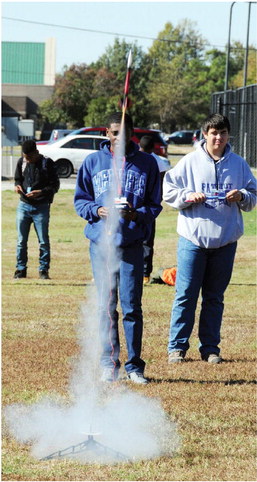MHS Rockets

MHS Rockets
Future NASA engineers send models into the strato-sphere
Marion School District Students in Christina Bolden’s 11th- and 12thgrade physics class at Marion High School set lofty goals for themselves for the past several weeks and may be blasting someone into a career in space flight or at the very least, helping propel manned spacecraft to distant planets.
As part of a yearly project, students built their own rockets from school purchased and approved kits and send them soaring into the sky.
“It takes them approximately three class periods to build and decorate their rockets and two class periods to launch all of them,” Bolden said.
It is more that a cardboard tube, pointed nosecone, some fins and solid fuel.
“The students first learn about projectile motion, gravitational force, air resistance and all three of Newton's laws of motion,” Bolden said, “and while they are building the rockets, the students learn about the effects of aerodynamic forces and the importance fin placement.”
It might be fun and games to send their rockets into the sky, but the project has a serious side. Students are graded on the assignment and must be able to describe the purpose and importance of all parts of the rocket, engine and recovery system.
Just one caveat, the student must have one successful launch.
The students also have to build a recovery system into their rockets that bring them safely back to earth with little or no damage.
After the first flight, students are allowed one modification to their rocket, whether it is adding weight, fins or just another coat of paint, then the craft are sent soaring again.
“The rocket engines used average eight Newton’s of thrust and an average altitude of 370 feet,” Bolden said. “Larger engines are available but make it difficult to track the rockets while in flight.”


By Mike Douglas


Share